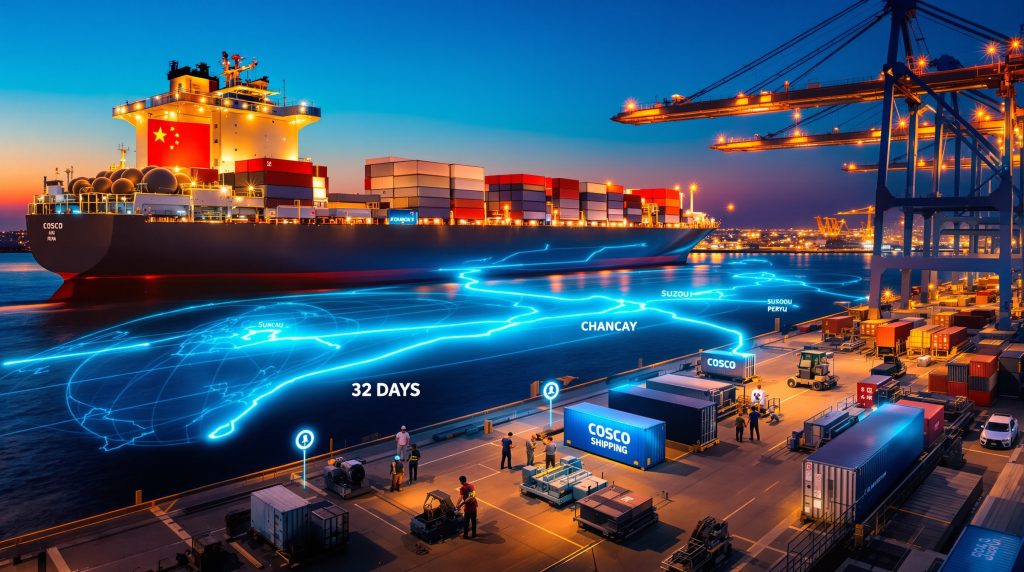How Does the New Suzhou-Chancay Shipping Route Work?
China has revolutionized maritime logistics between Asia and Latin America with the launch of its first direct break-bulk shipping service connecting Suzhou to Peru's Chancay port. This pioneering route represents a significant milestone in trans-Pacific trade relations, enhancing connectivity between the two regions while reducing costs and transit times.
The Pioneering Maritime Connection
The innovative direct shipping service launched recently represents China's growing commercial interests in Latin America. Operating on a monthly schedule, the service employs specialized vessels designed specifically for non-containerized cargo transport, addressing a crucial gap in the existing maritime logistics network between these regions.
This groundbreaking service reduces journey times by approximately 5 days compared to traditional shipping routes, bringing the total transit time to around 32 days. This improvement comes from bypassing traditional transshipment hubs and taking a more direct path across the Pacific Ocean.
COSCO Shipping Specialized Carriers operates the service, with plans to handle substantial cargo volumes annually. This operation complements China's broader strategy of developing dedicated maritime corridors to support its global trade ambitions.
Break-Bulk vs. Container Shipping: Key Differences
Break-bulk shipping offers distinct advantages over traditional container shipping for certain types of cargo. Unlike container vessels that transport standardized boxes, break-bulk carriers specialize in handling irregular, oversized, or unusually shaped cargo that cannot fit into standard shipping containers.
The specialized nature of break-bulk shipping makes it ideal for transporting mining equipment, industrial machinery, steel products, and other non-containerizable goods. These items are loaded individually using specialized cranes and securing methods, requiring different port infrastructure and handling expertise.
Break-bulk shipping provides greater flexibility for industrial equipment transport, as items don't need to conform to container dimensions. This is particularly valuable for Peru's mining industry trends, which relies heavily on specialized machinery that often exceeds standard container specifications.
The new service complements existing container shipping options between China and Peru, creating a more comprehensive logistics network. Container routes primarily handle consumer goods, agricultural products, and other standardized cargo, while the break-bulk service focuses on industrial equipment and oversized machinery.
What Makes Chancay Port Strategically Important?
The development of Chancay port represents one of China's most significant infrastructure investments in Latin America, strategically positioned to transform regional trade dynamics and strengthen economic ties between Asia and South America.
Gateway to Latin American Markets
Chancay port's strategic location approximately 78 kilometers north of Lima provides ideal access to Peru's economic heartland and broader South American markets. This positioning allows it to serve as a natural gateway connecting Asian exports with Latin American consumers and resources.
The port development required an investment of approximately US$3.5 billion, representing one of China's largest infrastructure commitments in the region. This substantial financial commitment underscores the strategic importance China places on establishing direct maritime connections with South America.
Construction began in 2021, with the port's inauguration taking place in November 2024 after the completion of its first development phase. This rapid development timeline demonstrates the priority given to establishing this strategic trade corridor.
The port operates as a joint venture between China's COSCO Shipping Ports and Peru's Volcan, with COSCO securing a 60-year operational concession. This long-term arrangement ensures China will maintain significant influence over this critical infrastructure for decades to come.
Economic Impact on Regional Trade
Chancay port functions as a comprehensive logistics hub connecting Asian manufacturers with Latin American markets, particularly benefiting industrial and mining sectors. The port's modern facilities and direct shipping connections reduce logistical complexities that previously hindered trade between these regions.
Economic analyses indicate the direct shipping routes could reduce transportation costs by over 20% compared to previous arrangements that required multiple transshipments. These savings come from eliminating intermediate handling, reducing insurance costs, and improving scheduling reliability.
The improved logistics infrastructure facilitates increased trade volume between China and Peru, whose bilateral trade has grown substantially in recent years. According to Peru's Ministry of Foreign Trade and Tourism, China has been Peru's largest trading partner since 2014, with two-way trade reaching significant levels.
The port strengthens China's trade presence throughout South America, providing easier access to markets in Colombia, Ecuador, Bolivia, and Chile through connecting transportation networks. This regional reach amplifies the economic significance of the Chancay development beyond Peru's borders.
What Cargo Does the Break-Bulk Service Transport?
The direct break-bulk shipping service carries specialized industrial equipment and raw materials crucial for Peru's economic development, particularly supporting its vital mining sector and infrastructure projects.
Industrial Equipment and Raw Materials
The service primarily transports grinding balls essential for mineral processing plants throughout Peru. These specialized steel balls are used in ball mills to crush ore into fine powder, a critical step in mineral extraction processes that forms the backbone of Peru's mining industry.
Energy storage cabinets and electrical equipment represent another significant cargo category, supporting Peru's growing energy infrastructure and industrial development. These components often have irregular dimensions that make them unsuitable for standard container shipping.
Steel round bars, construction materials, and structural components make up a substantial portion of the cargo, supporting Peru's construction and infrastructure development sectors. These materials provide essential inputs for both public and private construction projects throughout the country.
Jumbo bags and other specialized industrial goods round out the diverse cargo manifest, demonstrating the versatility of break-bulk shipping for handling non-standard items. These specialized containers transport everything from minerals to agricultural products in bulk quantities.
Mining Industry Supply Chain Support
The direct shipping service provides vital support to Peru's mining operations by ensuring reliable delivery of essential equipment and supplies. Peru ranks as the world's second-largest copper producer according to the U.S. Geological Survey, with mining contributing approximately 15% to the country's GDP according to Peru's Ministry of Energy and Mines.
The direct supply line to Peruvian mineral processing facilities significantly reduces lead times for critical components, minimizing operational disruptions. This reliability is particularly important in remote mining regions where equipment failures can cause costly production delays.
The service facilitates equipment delivery for resource extraction operations throughout Peru's diverse mining regions, from coastal operations to high-altitude Andean sites. This logistical support strengthens Peru's position as a major global mining producer, particularly for copper, silver, zinc, and gold.
The mining sector employs approximately 1.3 million people directly and indirectly in Peru, according to the country's National Society of Mining, Petroleum and Energy. The reliable supply of equipment and materials helps maintain operational continuity, supporting these employment opportunities.
How Does This Route Compare to Other China-Peru Shipping Options?
The new direct break-bulk shipping route offers distinct advantages over existing maritime connections, particularly for specialized cargo that doesn't fit well within traditional container shipping networks.
Time and Cost Efficiency Analysis
The direct route achieves a transit time of approximately 32 days, compared to 37+ days through traditional routes that require transshipment through intermediate ports. This time savings comes primarily from eliminating stops at transshipment hubs and taking a more direct oceanic path.
Traditional shipping routes from Asia to South America's west coast typically transit through the Panama Canal, adding approximately 5-7 days to journey times according to Panama Canal Authority transit statistics. The direct route avoids these potential bottlenecks and their associated delays.
Direct shipping routes can reduce transportation costs by eliminating transshipment requirements and port handling fees. According to World Bank reports on port performance, each additional handling event increases both costs and risks of damage or delays.
The monthly service frequency provides regular, predictable supply chain scheduling that allows businesses to plan inventory and production cycles more effectively. This predictability helps reduce safety stock requirements and associated carrying costs.
Complementary Shipping Networks
The break-bulk service strategically complements existing container shipping options, creating a more comprehensive logistics network between China and Peru. Container ships handle standardized cargo efficiently, while break-bulk vessels address the needs of oversized or irregularly shaped items.
Container routes primarily handle consumer goods and agricultural products, with standardized dimensions that optimize space utilization. These established routes continue to serve the bulk of trade between the two countries in terms of shipment volume.
The specialized break-bulk service focuses on mining equipment and oversized industrial goods that previously faced logistical challenges or required costly special handling arrangements. This differentiation allows each shipping mode to focus on its strengths.
The combined network strengthens overall China-Peru trade infrastructure, providing businesses with more options and greater flexibility. This comprehensive approach reduces logistics bottlenecks and supports expanded trade across multiple industry sectors.
What Are the Economic Benefits for Both Countries?
The direct break-bulk shipping route creates significant economic advantages for both China and Peru, strengthening bilateral trade relations while supporting key industries in both nations.
China's Strategic Advantages
The new route expands China's access to Latin American markets, supporting its broader strategy of diversifying global trade relationships. This direct connection facilitates more efficient export of Chinese industrial equipment, machinery, and manufactured goods to the region.
The route strengthens China's Belt and Road Initiative presence in South America, extending its global infrastructure network to a strategically important region. The BRI has invested over US$200 billion globally in infrastructure projects since 2013, according to the American Enterprise Institute China Global Investment Tracker.
Enhanced export capabilities for industrial equipment and machinery help Chinese manufacturers maintain competitiveness in Latin American markets. The improved logistics reduce delivery times and transportation costs, making Chinese products more price-competitive.
The direct connection increases China's influence in Peru's mining and infrastructure sectors, providing privileged access to critical minerals energy transition. Peru's mineral wealth, particularly copper, is strategically important for China's manufacturing and technology industries.
Peru's Economic Opportunities
Peru benefits from improved import efficiency for industrial equipment essential to its mining and manufacturing sectors. The direct connection reduces lead times for critical machinery and spare parts, minimizing operational disruptions.
The enhanced maritime connection strengthens Peru's export capabilities for agricultural products, including avocados, mangoes, and blueberries. According to Peru's National Statistics Institute, these high-value agricultural exports represent growing export categories to China.
Reduced shipping costs and transit times make Peruvian products more competitive in Asian markets, potentially opening new export opportunities. This cost advantage is particularly important for agricultural products where freshness impacts market value.
The development positions Peru as a regional logistics hub, potentially attracting additional investment in transportation infrastructure and value-added services. This hub status could generate additional economic activity beyond the direct trade benefits.
How Does This Route Support Peru's Mining Industry?
Peru's mining sector, which forms the backbone of its export economy, stands to benefit significantly from the dedicated maritime connection to China, one of the world's largest consumers of mineral resources.
Critical Supply Chain Infrastructure
The direct delivery of grinding balls and processing equipment addresses a crucial supply chain need for Peru's mining operations. These specialized components experience significant wear and require regular replacement to maintain processing efficiency.
Mining operations benefit from reduced lead times for essential machinery, minimizing costly production disruptions. In mining, equipment downtime can cost operations thousands of dollars per hour in lost production value.
Lower transportation costs for heavy industrial equipment improve the economics of mining operations, particularly for mid-sized companies. These savings can improve operational margins in an industry where global commodity price fluctuations create economic pressure.
The improved reliability for mining operations' supply chains helps stabilize production scheduling and operational planning. This predictability allows for more efficient inventory management and maintenance scheduling.
Resource Export Potential
The route enhances capabilities for copper concentrate and other mineral exports to Asian markets. Peru produces approximately 2.2 million tonnes of copper annually according to the International Copper Study Group, with China representing a primary export destination.
The direct connection streamlines logistics for mineral shipments, reducing handling events that can impact quality and increase insurance costs. This streamlining is particularly valuable for high-value mineral concentrates that represent Peru's primary export commodities.
The improved connection supports Peru's position as a major global copper producer, facilitating more efficient market access. According to the U.S. Geological Survey, Peru ranks second globally in copper production, behind neighboring Chile.
The enhanced logistics connection creates potential for increased mineral processing within Peru, potentially capturing more value from mineral resources before export. This vertical integration represents a long-term economic development opportunity for Peru.
What Future Developments Are Expected?
The inaugural direct break-bulk shipping service likely represents just the first phase of an evolving maritime connection that could expand significantly as trade volumes grow and relationships deepen.
Expansion Possibilities
Industry analysts anticipate potential increases in service frequency beyond monthly sailings as trade volumes grow and the route proves its economic viability. Additional sailings would further improve supply chain reliability and capacity.
Maritime logistics experts suggest the possible addition of more specialized vessels to the route, potentially including heavy-lift ships for project cargo or roll-on/roll-off vessels for wheeled equipment. This fleet diversification would expand the range of cargo that could be transported directly.
As bilateral trade grows, expansion of cargo types and volumes would naturally follow, potentially including specialized mining equipment, larger industrial machinery, and specialized vehicles. This cargo diversification would strengthen the economic foundation of the service.
The direct route could eventually integrate with other regional shipping networks, creating a more comprehensive transportation ecosystem connecting multiple South American ports with Asian markets. This network development would enhance the strategic value of the Chancay port infrastructure.
Long-Term Trade Implications
Economic forecasts suggest growing bilateral trade volumes between China and Peru, building on the already substantial relationship where China serves as Peru's largest trading partner. This growth trajectory creates natural pressure for expanded shipping capacity.
The port development is likely to attract complementary industries seeking to benefit from improved logistics infrastructure, potentially including warehousing, distribution centers, and value-added services. These supporting businesses create additional economic activity and employment.
Increased Chinese investment in Peruvian infrastructure and mining sectors would naturally follow the improved logistics connection, as reduced transportation costs improve project economics. This investment could accelerate Peru's industrial development and resource utilization.
The direct connection strengthens economic ties between Asia and Latin America more broadly, potentially serving as a model for similar direct maritime connections to other South American countries. This regional impact extends the strategic significance beyond bilateral relations.
What Makes Chancay Port a Flagship Belt and Road Project?
Chancay port represents one of China's most significant infrastructure investments in Latin America, exemplifying key principles of the Belt and Road Initiative while establishing a strategic foothold in South America.
Infrastructure Development Model
The total investment of approximately US$3.5 billion makes Chancay one of the largest BRI projects in Latin America, demonstrating China's commitment to developing strategic infrastructure in the region. This substantial financial commitment highlights the port's importance within China's global investment strategy.
The development employs a public-private partnership structure that combines Chinese expertise and financing with local knowledge and market access. This collaborative approach helps address potential concerns about foreign control of critical infrastructure.
The port integrates with existing transportation networks, including the Pan-American Highway, maximizing its economic impact and utility. This integration enhances the port's function as a logistics hub connecting maritime and land transportation systems.
The strategic positioning gives China significant influence over a major South American trade gateway, supporting broader geopolitical and economic objectives. This positioning aligns with China's long-term strategy of developing alternative trade corridors globally.
Broader Regional Significance
Chancay serves as a gateway to western South American markets beyond Peru, potentially reaching Bolivia, Colombia, Ecuador, and Chile through connecting transportation networks. This regional reach amplifies the economic and strategic significance of the investment.
The direct shipping routes reduce dependence on the Panama Canal for Asia-South America trade, creating a more direct and potentially more reliable connection. This alternative route provides strategic redundancy in maritime logistics between these regions.
The project serves as a model for future Chinese infrastructure investments in Latin America, demonstrating the potential benefits of BRI partnerships in the region. Successful implementation could pave the way for similar investments in other South American countries.
The development enhances Peru's position in global trade networks, potentially attracting additional investment and commercial activity. This improved connectivity can catalyze broader economic development beyond the immediate port operations.
FAQ: China-Peru Direct Shipping Routes
How much cargo can the break-bulk service transport annually?
The direct break-bulk shipping service has substantial capacity, though exact figures require verification from official sources. The monthly service frequency provides regular capacity for industrial equipment, machinery, and specialized cargo between China and Peru's west coast.
Break-bulk vessels typically carry between 20,000-40,000 deadweight tonnes per voyage, depending on cargo density and vessel specifications. This capacity focuses specifically on non-containerized cargo that requires specialized handling.
Industry standards suggest utilization rates typically range from 70-85% for established break-bulk routes, with higher utilization expected as the service matures and establishes reliable cargo flows. This utilization develops as shippers incorporate the route into their logistics planning.
Maritime industry experts note that break-bulk shipping capacities are typically measured in both weight (tonnes) and volume (cubic meters) due to the varied nature of the cargo, with capacity constraints often determined by cargo characteristics rather than vessel limitations.
What types of agricultural products does Peru export to China?
Peru's agricultural exports to China have diversified and grown substantially in recent years, creating significant economic opportunities for Peruvian producers. Fresh fruits represent Peru's fastest-growing agricultural export category to China.
Avocados have become a major export product since China granted market access, with sales growing substantially year-over-year according to Peru's agricultural export statistics. The improved shipping connection helps maintain product freshness during transit.
Mangoes represent another significant fruit export to China, with Peruvian varieties gaining popularity in Chinese markets. These tropical fruits benefit significantly from reduced transit times, as quality and shelf life are directly impacted by transportation duration.
Blueberries have emerged as a high-value export crop, with Peru becoming a major global supplier during counter-seasonal production periods relative to Northern Hemisphere producers. The high value-to-weight ratio of blueberries makes them economically viable for international shipping despite their perishable nature.
How does the Chancay Port connect to Peru's transportation network?
Chancay Port's strategic location approximately 78 kilometers north of Lima provides ideal access to Peru's economic heartland and transportation infrastructure. This positioning minimizes inland transportation costs for both imports and exports.
The port connects directly to the Pan-American Highway, the major north-south transportation corridor spanning multiple South American countries. This connection facilitates efficient distribution of goods throughout Peru and to neighboring countries.
The port development includes purpose-built access roads designed to handle heavy industrial traffic, improving transportation efficiency between the port and inland destinations. These dedicated corridors help reduce congestion and transportation costs.
Future plans include potential rail connections to enhance multimodal transportation options, though these remain in development phases. Rail infrastructure would further strengthen the port's function as a regional logistics hub.
What is the difference between break-bulk and container shipping?
Break-bulk shipping transports cargo that is loaded individually rather than in standardized containers, offering flexibility for oversized or irregularly shaped items. This approach allows for customized handling of each piece of cargo according to its specific requirements.
Container shipping utilizes standardized boxes (typically 20 or 40 feet long) that can be efficiently stacked and transferred between vessels, trucks, and trains. This standardization creates significant efficiency in handling but limits the dimensions of cargo that can be transported.
Break-bulk vessels feature specialized cranes, equipment, and securing systems designed specifically for non-containerized cargo. These specialized handling capabilities allow them to safely transport heavy machinery, steel products, and industrial equipment.
Container ships optimize space utilization through standardization, while break-bulk vessels sacrifice some space efficiency to accommodate irregular cargo dimensions. This fundamental difference results in different economic models, with break-bulk typically commanding higher rates per tonne but offering greater flexibility.
A New Chapter in Trans-Pacific Trade
The direct break-bulk shipping route between Suzhou and Chancay represents a significant advancement in China-Peru trade relations, creating new opportunities for both nations while strengthening economic ties across the Pacific.
The specialized maritime connection substantially improves logistics for industrial equipment and mining supplies, reducing costs and transit times for these critical cargo categories. These improvements support Peru's vital mining sector while enhancing market access for Chinese manufacturers.
As part of China's broader Belt and Road Initiative, the Chancay Port development demonstrates how targeted infrastructure investments can transform international trade corridors. The approximately US$3.5 billion investment creates ripple effects throughout regional transportation networks.
The complementary nature of break-bulk and container shipping services between China and Peru creates a comprehensive logistics ecosystem that can accommodate diverse cargo requirements. This system supports both standardized consumer goods and specialized industrial equipment.
Looking forward, the direct maritime connection is likely to catalyze additional investment and trade growth between China and Peru, potentially expanding to include other South American nations. The strategic infrastructure positions Peru as a regional gateway for Asian trade.
As this maritime corridor matures, it will likely stimulate complementary developments in warehousing, distribution, and value-added services around the Chancay port complex. These additional activities will further enhance the economic impact beyond the direct shipping benefits.
The pioneering route represents just the beginning of what could become a transformative shift in trans-Pacific trade patterns, creating new opportunities for economic cooperation while strengthening strategic relationships across continents. However, the US-China trade war impacts and tariff impact analysis suggest that these developments will occur against a backdrop of evolving global trade tensions, adding another dimension to this maritime breakthrough. Furthermore, the innovation expo insights from recent industry gatherings point to continued technological advancements that will likely shape the future of these shipping corridors.
Are You Positioned for the Next Major Mining Breakthrough?
Discovery Alert's proprietary Discovery IQ model provides instant notifications on significant ASX mineral discoveries, delivering actionable insights for both short-term traders and long-term investors. Explore how historic discoveries have generated substantial returns by visiting our dedicated discoveries page and position yourself ahead of the market today.




